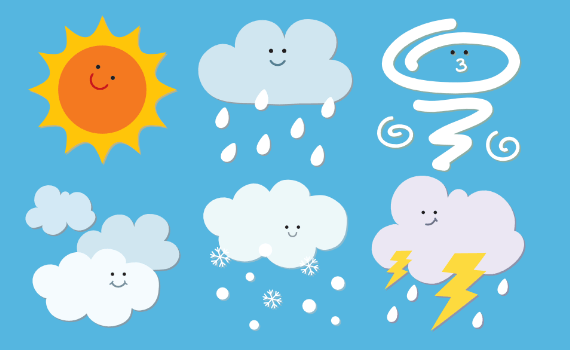
Weather

Natural Disasters

Experiments

Kid's Zone
Temperature
- Temperature Questions
- Wind Chill
- Heat Index
- Temperature Definitions
- Heat Wave Safety
- Temperature Activities
What is temperature? Temperature is a degree of hotness or coldness the can be measured using a thermometer. It’s also a measure of how fast the atoms and molecules of a substance are moving. Temperature is measured in degrees on the Fahrenheit, Celsius, and Kelvin scales.
Click here to use a temperature conversion calculator!
How do you find the temperature for a specific day? First, go to http://weather.gov. Then, click on the map for the place you are looking for. After that, look for a section called Climate. Beneath that title, read what is labeled and click on the one that most suits what you are looking for. This should take you into the National Weather Service’s climatic data information for your specific area.
Why can you see your breath when its cold outside? Your breath is reasonably warm and humid and it has invisible water vapor as a large component of the gas. Warm moist air meeting the cooler air outside the body causes the invisible water vapor to condense the cooler air outside are visible and form the cloud that you see. The relative humidity which depends upon water content and temperature goes to 100%. As the breath gets further from the person’s face the water content dilutes and the relative humidity goes down and the droplets go back into vapor form.
Can you tell the temperature by listening to the chirping of a cricket? Yes! The frequency of chirping varies according to the temperature. To get a rough estimate of the temperature in degrees Fahrenheit, count the number of chirps in 15 seconds and then add 37. The number you get will be an approximation of the outside temperature.
What is the Wind Chill Index? The wind chill index is the temperature your body feels when the air temperature is combined with the wind speed. The higher the wind speed the faster exposed areas of your body lose heat and the cooler you feel.
What is the Heat Index? The Heat Index is a combination of air temperature and humidity that gives a description of how the temperature feels. This is not the actual air temperature.

What is Heat Stroke? Heat Stroke is the most severe form of heat injury and is a life-threatening emergency. It is the result of long, extreme exposure to the sun, in which a person does not sweat enough to lower body temperature. Take a look at the chart below to see what the Heat Index needs to be for you to get heat stroke.
| HEAT INDEX | AFFECTS TO THE HUMAN BODY |
| 130° or Above | Heat Stroke highly likely with continued exposure |
| 105° to 130° | Heat Stroke likely with prolonged exposure |
| 90° to 105° | Heat Stroke possible with prolonged exposure |
WIND CHILL ADVISORY – Issued when the wind chill temperature is forecast to be between -15°F to -24°F.
WIND CHILL WARNING – Issued when the wind chill temperature is forecast to be -25°F or lower.
HEAT ADVISORY – Heat Index is greater than or equal to 105°F and less than 115°F for less than 3 hours per day. Also, nighttime heat indices should remain above 80°F for at least 2 consecutive days.
EXCESSIVE HEAT WATCH – Heat indices of 115° F or greater may occur in the next few days.
EXCESSIVE HEAT WARNING – Heat Index is 115°F or greater for more than 3 hours per day for at least 2 consecutive days.
Click Here to see if there are any active warnings in your area.
Extremely hot weather takes a large toll on the human body. In an average year, the summer heat in the U.S causes about 175 deaths. People most at risk for heatstroke are the elderly, small children, and people with weight and alcohol problems. Always listen to the radio and television for the latest information and instructions for your area.
HEAT WAVE SAFETY TIPS:
- Slow down!
- On a hot day, don’t perform strenuous activities.
- Dress for summer. Wear lightweight, light-colored clothing.
- Drink plenty of water. Your body needs water to keep cool.
- Spend more time in air-conditioned places.
- If you don’t have air-conditioning, then have plenty of fans.
- Don’t get too much sun.
- Heatstroke, heat exhaustion and sunstroke are possible with prolonged exposure to the heat.
- If someone gets heatstroke or heat exhaustion seek medial attention immediately.
Lesson Plan: Here is a great lesson plan on how to read a thermometer. In this activity, kids learn about the difference between Celsius and Fahrenheit.
Lesson Plan: Here is a great lesson plan that teaches students how to read a thermometer. In this activity, kids practice reading and recording temperatures.
Lesson Plan: Here is a great lesson plan on measuring temperatures. In this activity, students will learn what the word degree means and will learn more about how temperature impacts their life.
Make A Thermometer Experiment: Here is a great experiment that allows the kids to make a thermometer.
Melting Snow Experiment: Here is a great experiment that teaches kids the difference between the freezing and melting process. It allows kids to take the temperature of a glass of snow. Then, watch the snow melt and observe how the temperature changed.
Science Fair Project Ideas: Here is a complete list of science fair project ideas. Discover the science behind the weather that impacts us every day.


